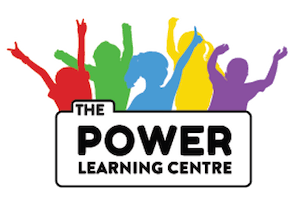Group Activities
Home / Group Activities
Group learning, also known as cooperative learning, or peer instruction, refers to children who work together to learn. It is most efficient when children understand they are accountable for their own work, but at the same time, they get to practice team-building and collaborative skills. It brings together an array of perspectives, knowledge, skills, and understanding. This pool of knowledge can then be shared and make it easier to understand new topics. When it comes to group learning, everyone has a voice. The group learning setting allows each individual member to communicate their ideas and strengthen their verbal communication skills. Children in a group learning environment get to practise their active listening skills and learn to listen with intent.
Collaborative learning enhances critical thinking. It fosters discussion and necessitates speaking, considering, and listening. The combination of ideas and perspectives also sparks a realm in which children get to think differently about situations and approach problems in novel ways. It opens the door to exploring different trains of thought and ways of solving problems based on a broad array of life experiences.
One of the greatest benefits that children get to reap during group learning is the relationships that they build with their peers. It provides a positive learning experience. Developing interpersonal relationships can come naturally when learning in a group setting because everyone is working towards achieving the same goal. With the foundation of alignment in place, children can expand their conversations and get to know one another on a more personal level.
While some children may take some time to get used to group learning, especially when they are more introverted, the reward of it will eventually pay out. They have resources in the form of peers when they hit a roadblock and can leverage each other’s knowledge base to overcome challenges together. Social groups are excellent ways for children to engage in peer interaction, learn appropriate communication and develop new friendships. The difference is that our instructors are skilled, sympathetic, and qualified to cater to children with additional needs. This then becomes a springboard for your child to actively engage in an identical direction in school. We provide weekly art, dance, music, and even yoga and meditation group classes!
We ensure children reach their full potential!
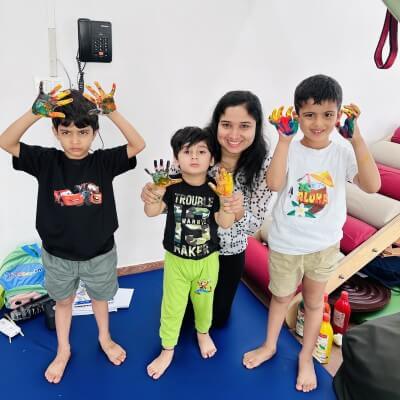
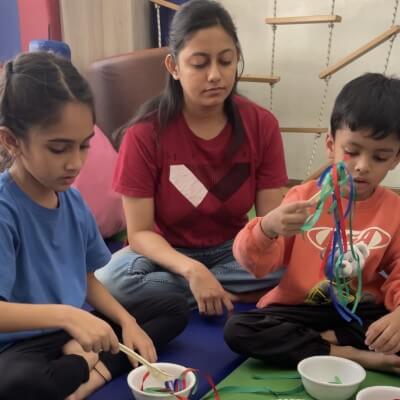
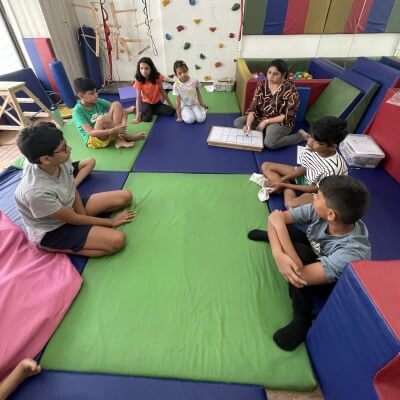
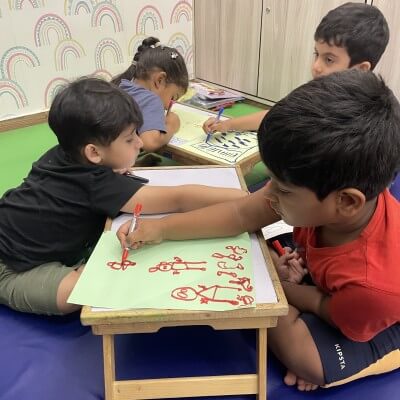
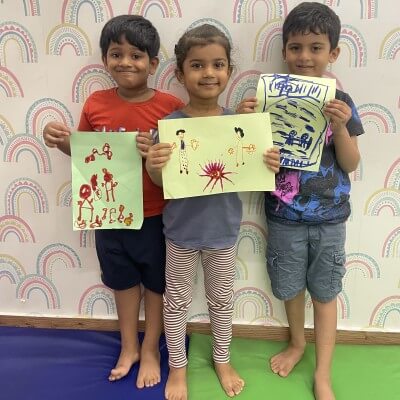
Frequently Asked Questions
What are the benefits of group occupational therapy sessions?
Group OT sessions offer several unique benefits:
- Social Skills Development: Children learn turn-taking, cooperation, communication, and empathy.
- Peer Modeling: Kids observe and learn from peers with similar challenges or strengths.
- Motivation and Engagement: Being part of a group can increase participation and enjoyment.
- Generalization of Skills: Helps children apply learned skills in a more natural, social context.
- Confidence Building: Success in a group setting can boost self-esteem.
How are the groups formed? Are they based on age, skill level, or specific needs?
Groups are typically formed based on a combination of:
- Age – so developmental levels are similar.
- Skill level – to ensure peers can work on similar goals together.
- Specific needs – such as sensory processing, fine motor skills, attention, or social interaction.
What kind of activities are included in group OT sessions?
Activities vary depending on goals, but may include:
- Sensory play (e.g., obstacle courses, tactile bins)
- Fine motor tasks (e.g., crafts, building with small objects)
- Social games (e.g., role-playing, board games)
- Gross motor challenges (e.g., relay races, yoga)
- Group projects to build cooperation and planning skills
How many children are in each group?
Most groups consist of 3 to 6 children, depending on:
- The nature of the goals being addressed
- The age and needs of the children
- Therapist availability and space
Smaller groups may be used for children who need more support.
How often do group sessions meet?
- Typically 1–2 times per week
- Frequency can vary based on the program, the child’s needs, and insurance coverage
How long are group OT sessions?
- Most sessions last 45 to 60 minutes
- Younger children may have shorter sessions (30–45 minutes)
How do I know if group therapy is right for my child?
Group therapy might be right if your child:
- Struggles with social skills or peer interactions
- Needs practice generalizing skills into real-life settings
- Benefits from peer modeling or motivation
- Has plateaued in individual therapy and may thrive in a more dynamic setting
An occupational therapist can evaluate your child and recommend whether group therapy is a good fit.
Can my child participate in both individual and group therapy?
Yes, many children benefit from a combination of individual and group sessions. Individual therapy allows for focused, personalized interventions, while group therapy offers a chance to practice those skills in a social context.It is an eating disorder where people limit the amount or type of food they eat.
How can group therapy help with social interaction challenges?
Group therapy provides a structured and supportive environment where children can practice social skills in real time with peers. Through therapist-guided activities, they learn how to:
- Initiate and maintain conversations
- Read social cues
- Handle conflicts
- Take turns and share
These interactions are monitored and coached by a therapist, allowing children to learn from both successes and challenges in a safe setting.
My child gets easily bored or has difficulty focusing in a group setting. How will the therapist manage this?
Therapists are trained to keep sessions engaging and developmentally appropriate. To manage attention and interest:
- Sessions include interactive games, movement breaks, and varied activities to match attention spans.
- Small groups are often formed based on age or developmental level to ensure relevance.
- The therapist may use visual aids, sensory tools, or behavior strategies like positive reinforcement to maintain focus.
What if my child has behavioral issues in a group?
Behavioral issues are common, and therapists are prepared to handle them. Here’s how they respond:
- Set clear expectations and group rules from the start.
- Use behavior management strategies (e.g., token systems, praise, redirection).
- Address disruptive behavior calmly and consistently, while keeping the group safe and inclusive.
- Communicate with you to reinforce strategies at home if needed.
How will the therapist track my child's progress in a group setting?
Progress tracking typically includes:
- Observational notes on social behaviors, participation, and peer interaction.
- Goal-setting for each child, reviewed periodically.
- Checklists or rating scales used before, during, and after sessions.
- Regular team meetings to discuss each child’s development and adjust strategies.
Will I receive updates or reports on my child's progress in group therapy?
Yes, most therapists provide regular updates through:
- Brief parent check-ins after sessions
- Scheduled progress meetings (monthly or quarterly)
- Written reports or summaries
- Email or phone communication, depending on your preference and the provider’s
My child is very shy. Will they be pressured to participate in group activities?
No, participation is encouraged but never forced. Therapists are sensitive to shy or anxious children and will:
- Use gentle encouragement and build trust gradually
- Allow your child to observe at first before joining in
- Pair them with a “buddy” or small group to make participation less intimidating
Offer positive reinforcement for even small steps toward engagement
What if my child doesn't seem to be enjoying or engaging in the group sessions?
If a child isn’t engaging, the therapist will:
- Assess whether the group is the right fit (e.g., age, level, interests)
- Adjust activities to be more motivating
- Explore underlying reasons (e.g., anxiety, mismatch with group dynamics)
- Communicate with you to discuss next steps — this could include individual sessions, a different group, or integrating interests into therapy.
See what our clients says!
Indrani M.
The warm, playful and attractive environs of Power Learning is gradually turning out to be an invaluable part of Kia's support system. Snehal (her OTist) is an energetic, knowledgeable and highly personable individual, who works very closely with me to model a streamlined and comprehensive sensory approach for my child. Kia loves her!
Meghna (her Speech and Language therapist) is talented and superbly dynamic in her methodology. She is professional and confident in her field, very warm and loving with my daughter and uses fun and innovative approaches to address Kia's functional language requirements.
BIG love and thanks to Anisha and Dev, for having such a lovely niche in Bombay for our special little angels.
Jaanya B.
Ishana comes home everyday telling me stories about how fun it is to be at Power Learning.
Ms Parul & Ms Swati
I'm very much aware of the effort you put into each child. Thank you for going above and beyond for Ishana and being such a caring Teacher to her.
Ms Arpita & Ms Minali
Your play based learning approach is Amazing! Thank you for instilling love of learning into my child. It has a pleasure watching her enjoying every bit of her class.
Ms Maitri
Teachers require so many positive qualities like Care, Compassion, Patience and Commitment. You have all the qualities in Abundance. Thank you for all you do!
Ms Anisha
It's great to see how visible and accessible you are around Power Learning! You are always available for discussions with us at all times. Coming to Mumbai from Indonesia was not easy until I found Power learning Center, Truly appreciate your Guidance and Love.. keep up the good work and I hope to see a marked improvement in my child very soonThank you! Thank you! Thank you!!🙏♥️
Yogita M.
For me, Power Learning is a One Stop Solution! Equipped with state of art facilities and excellent therapists this centre has it all under one roof.
Snehal ( OTist) and Meghna ( Language therapist ) have both used tailor made strategies to work on my daughter’s needs. Moreover , both ensure that i am kept informed on the road map for my child and also follow a similar approach at home.
Although, this is just the beginning and consistency is the key , I can certainly say that 3 weeks of intensive therapy has shown noteworthy positive changes in my daughter such as increased focus / attention span , improvement in expressive language and social skills.
Big Thank You to the dynamic team of specialists at Power Learning . Special thanks to Parul , Anisha & Dev.
- Juhu
3rd Floor, Film Industry Welfare Trust Building, Next to Ajivasan Hall, Juhu Tara Road, Mumbai – 49.
- Goregaon
APML Towers, 5th Floor, 53/1 Vishweshwar Nagar Road, Opp. Pravasi Industrial Estate, Goregaon (East), Mumbai- 63.
- +91 90040 53414
- +91 85915 72877
- anisha@powerlearning.app
- parulm@powerlearning.app
